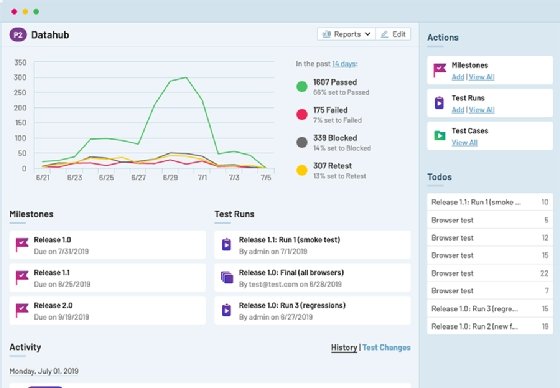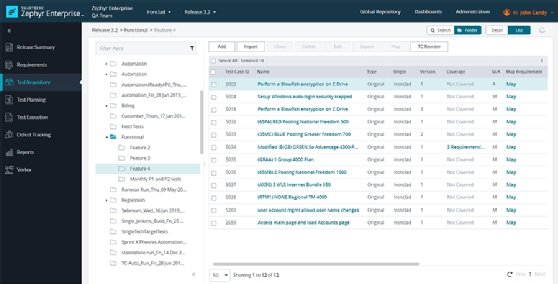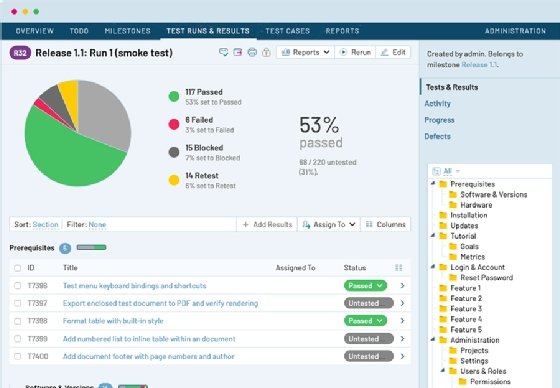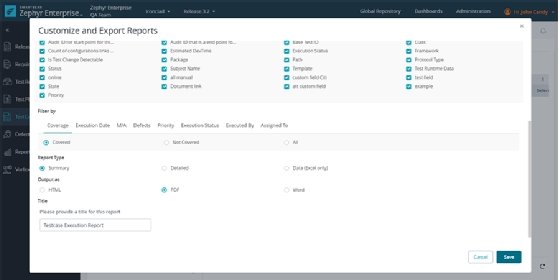
animind - Fotolia
Assess TestRail vs. Zephyr test management tools
TestRail and Zephyr offer test management capabilities and integrate with tools that development teams rely on, like Jira. Check out features and user reviews for each product.
Testing validates software against its business and technical specifications and requirements. Software is complex, and so is testing. That's why many organizations use a test management tool.
Test management helps address many problems. Without it, quality engineers can miss execution paths, fail to follow defects through to correction and allow releases without complete certification.
Test management tightly integrates with all phases of testing. Test management affects application lifecycle management (ALM) at each stage of software release. Without test management, you don't have independent software QA.
Test management comprises the following:
- test development
- test case management
- test execution
- issue management and ALM integration
Idera's TestRail and SmartBear's Zephyr are leading test management products. Each tool offers varying levels of support, which can make it difficult to compare them. To put TestRail vs. Zephyr on level ground, we focus on a specific ALM framework built around Atlassian Jira for project management.
Inside TestRail and Zephyr
TestRail was created by Gurock Software and acquired by Idera in 2016. Idera's product offering includes database and developer tools, as well as other IT software. It's possible to build an ecosystem around TestRail with these related products. TestRail is one of the hottest apps in the Atlassian Marketplace, appearing in its top trending and top rated lists. Zephyr also offers an Atlassian integration, and the app is among the top sellers in the marketplace.
SmartBear acquired Zephyr in 2018 to add to its portfolio of software testing tools. Zephyr integrates with other SmartBear tools, like TestComplete, and also with the Atlassian software framework via Zephyr for Jira. Zephyr sits on the top rated, top selling and top trending lists in the Atlassian Marketplace.
These tools both offer standard test management features, including analytics for test results, reporting, test control and management of test cases. Each tool also integrates results with problem tracking systems, like Jira. Neither tool provides test data generation or builds the tests; they're test management tools, not builders.
Test management in TestRail and Zephyr
Both products integrate with other tools for steps in ALM or QA frameworks, including test data generation and test creation. Both TestRail and Zephyr provide strong GUI and reporting features to track test progress, identify pass/fail conditions and pass defects to the rest of the ALM flow.

Zephyr is a broad Agile software testing framework that tightly integrates with Atlassian Jira. While you can run Zephyr without Jira, most users implement it in their framework. Zephyr's marketing highlights that it is a test management tool native to Jira.
There are two versions of Zephyr. Zephyr for Jira is designed as a Jira plugin. That's the version available on the Atlassian Marketplace. Zephyr Enterprise enables test management and control in a way that can integrate with Jira but lives outside it. Zephyr Enterprise requires a different level of integration, but it's a good choice for businesses that have a mix of projects managed in Jira and other tools.
Users generally prefer the Jira version of Zephyr over the standalone version. Without Jira, ALM and QA tend to be more variable. There are more potential integration issues with a standalone version of a tool versus the specialized plugin. Thus, Zephyr for Jira doesn't see the integration challenges that crop up when there's no common software project management framework.
TestRail orients itself differently than Zephyr. TestRail centers on test cases, while Zephyr focuses on the test management flow. TestRail runs on most devices. TestRail, too, integrates with Jira and other development management tools.
Idera offers several versions of TestRail. Both TestRail Professional and TestRail Enterprise are available as standalone installations or in SaaS form. Both versions integrate with Jira using the TestRail for Jira Test Management plugin, which takes a little more effort to set up, like Zephyr's Enterprise product. There might be a slight bias among users toward Zephyr as a Jira plugin, but TestRail's standalone product is preferred over Zephyr's.
How the tools manage tests
In test development, both products define tests in a hierarchy, starting with the software elements, moving to versions and then to tests. Users say it's somewhat easier to create a test plan that involves multiple test cases in TestRail. Zephyr, they say, might require multiple steps.
Zephyr carries the hierarchical model into the definition of test requirements. Users like this feature because it links test cases back to the requirements phase in the same way they're maintained at the test level.

While both test management tools integrate with the overall SDLC framework, Zephyr seems more tightly coupled to Jira practices overall, even in standalone form.
Test case management is a core capability in this tool sector. Both of the vendors provide a good GUI for QA personnel to access their projects, to-do lists and status information. Both tools collect and correlate test results. TestRail is slightly more effective with the introduction of ad hoc direct testing, which users like as a way to either verify a problem or quickly rerun a test because of a flaw in setup.

Test execution is the other pillar of test management. Test execution encompasses several points, including the ease of integration with test automation software, the quality and customization of the reports, and overall ease of use.
SmartBear has worked hard on Zephyr integration with test automation software. While TestRail's capabilities are generally the same, it's a bit harder to dig out of the material. However, TestRail is typically used in more complex environments than Zephyr.
For the overall graphics and report structure, both companies offer roughly the same level of information. But TestRail seems to handle more on its own, where Zephyr relies on integration with other elements of the Atlassian or SmartBear ecosystems. Users rate Zephyr as slightly better for custom report generation, but those same users prefer the standard reports of TestRail.
Let's look at issue management and integration with problem tracking and ALM software. Both products integrate with issue trackers, but TestRail Enterprise gets the users' nod for a broader range of integrations. Zephyr has a slight advantage in providing a specific module framework through which issues are integrated. Some users think this makes it easier to track how bugs are reported and resolved.

Performance and scalability are also big issues for software creators. Some users say that software organizations ease into test management as a discipline; they will start with some limited number of software projects and grow with experience. In this area, TestRail is favored because users report that Zephyr performance can degrade with the scale of the project.
Pick your product: TestRail vs. Zephyr
Customers use a variety of adjectives to describe TestRail, such as "complete," "flexible," "powerful" and "adaptable." Users call Zephyr "easy to use" and "quick to learn" and say that it fits most team requirements and integrates well with Jira. If there is a difference at a high level between the two test management tools, these points illustrate it.
Test management depends on the overall flow of ALM, SDLC and QA systems; the type of projects; the size and experience of the organization; and the tools already in use. Ask a couple of teams in parallel to consider both test management tools, and then make a decision that fits the particular situation at your organization.
There's one final point to discuss in this TestRail vs. Zephyr comparison. We found more users who said they would not use or recommend Zephyr than those who held that negative sentiment about TestRail.
Ultimately, TestRail rarely disappoints users. The product handles key tasks and includes useful features, even though it's not the easiest product to learn and use. Zephyr has a faster learning curve but seems shorter on capabilities that facilitate adapting to varied ALM flows.







